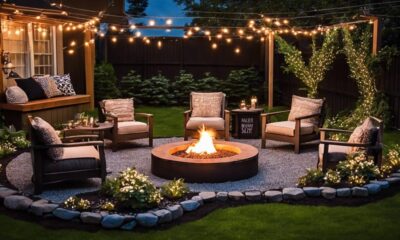Architecture Home Styles
10 Popular House Styles in Canada
Bask in the diverse beauty of Canadian architecture with these 10 popular house styles that will leave you eager to explore more.

When examining the array of architectural styles present in Canada, one cannot help but be intrigued by the ten popular house styles that stand out amidst the landscape.
From the modern allure of sleek lines to the cozy charm of cottage living, Canada offers a rich tapestry of housing options that cater to diverse tastes and preferences.
Let's explore how these unique styles blend tradition with innovation, providing a glimpse into the fascinating world of Canadian architecture.
Key Takeaways
- Modern Style Houses prioritize open concept living and luxurious materials for a contemporary feel.
- Ranch Style Homes offer simplicity, horizontal lines, and single-level living for easy accessibility.
- Cottage Style Residences embody traditional design with cozy wood features and a nostalgic charm.
- Tudor Revival Residences showcase steep roofs, decorative half-timbering, and leaded glass windows for elegance and character.
Modern Style Houses
Modern style houses in Canada typically prioritize architectural design and open concept living areas to create a sleek and contemporary living environment that emphasizes practicality and style. These modern homes often feature open floor plans that connect the kitchen, dining, and living areas, fostering a sense of togetherness and fluidity within the space. The influence of West Coast style can be observed in Canadian modern houses, with their innovative designs tailored to rugged terrains and a strong emphasis on using natural materials like wood and glass.
Canadian modern homes are known for their luxurious materials, such as marble countertops and high-end furniture, while also embracing a minimalist approach to living, encouraging residents to declutter and live with only essential possessions. The design aesthetics of these homes revolve around blending harmoniously with the surrounding environment, maximizing natural light, and offering breathtaking views of the outdoors. This results in a cohesive and visually appealing living space that caters to contemporary tastes while prioritizing functionality and comfort in the modern Canadian home.
Ranch Style Homes
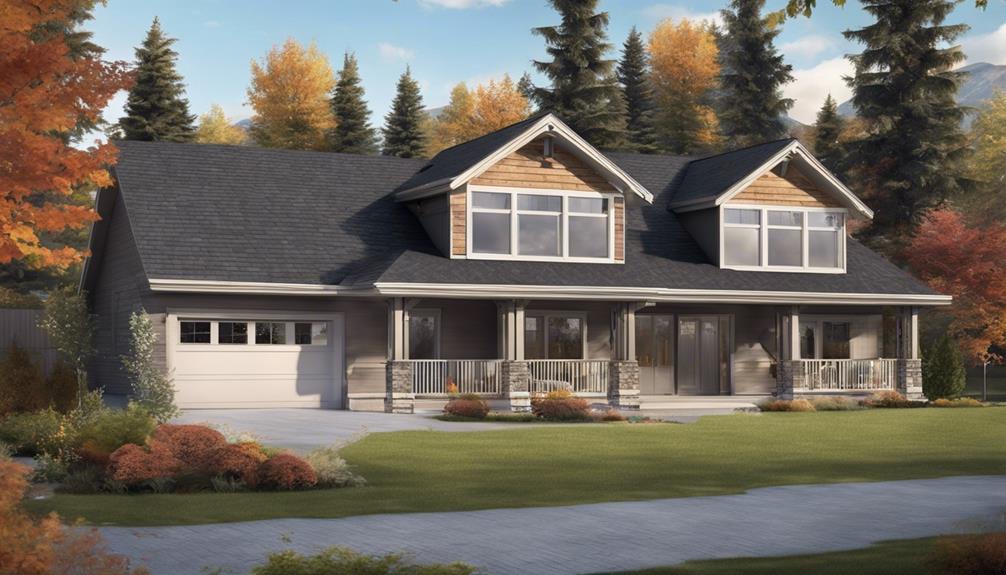
Emphasizing horizontal lines and simplicity in design, ranch style homes in Canada boast long ground-level facades that exude a timeless charm and practicality for comfortable living. These homes typically feature open floor plans, with spacious interiors that flow seamlessly from one room to another. Commonly built with wood materials, ranch style homes offer warm and welcoming spaces for comfortable living. Ideal for those who prefer single-level living, ranch style homes eliminate the need for stairs and provide easy accessibility. With a focus on blending indoor and outdoor spaces, ranch style homes often have large windows to bring in natural light and views of the surrounding landscape.
- Ranch style homes have long ground-level facades, emphasizing horizontal lines and simplicity in design.
- These homes typically feature open floor plans, with spacious interiors that flow seamlessly from one room to another.
- Commonly built with wood materials, ranch style homes offer warm and welcoming spaces for comfortable living.
- Ideal for those who prefer single-level living, ranch style homes eliminate the need for stairs and provide easy accessibility.
- With a focus on blending indoor and outdoor spaces, ranch style homes often have large windows to bring in natural light and views of the surrounding landscape.
Cottage Style Residences
Characterized by their smaller size, traditional design, and extensive use of wood features, cottage style residences in Canada create a cozy and simple living atmosphere that appeals to those seeking a traditional and down-to-earth living experience.
These homes exude a warm and inviting interior ambiance, perfect for smaller living spaces. Loaded with charming wood elements, cottage style houses offer a comforting and rustic aesthetic appeal.
The organic and cozy feel of these homes, along with practical furnishings and simplicity in design, make them a popular choice for individuals looking for a traditional and welcoming living environment in Canada.
The traditional design elements of cottage style residences harken back to a simpler time, evoking a sense of nostalgia and charm. Wood features such as exposed beams, hardwood floors, and wooden accents throughout the home contribute to the cozy and inviting atmosphere that defines cottage style living.
Country Style Dwellings

Moving from Cottage Style Residences to Country Style Dwellings reveals a shift towards larger, more spacious homes in Canada, characterized by a blend of wood and other materials that evoke a sense of tradition and simplicity.
Country style dwellings in Canada embrace wooden elements, big windows, traditional design, and spacious houses, creating a warm and inviting atmosphere for residents. These homes are crafted with a mix of wood and other materials, reflecting a humble and traditional aesthetic.
The emphasis on wooden furniture and fixtures enhances the connection to nature, infusing the interiors with a down-to-earth and organic ambiance. Country style houses typically sit on large plots of land, ideal for accommodating big families seeking a cozy yet practical living environment.
The simplicity and durability of these dwellings cater to individuals who appreciate a rustic and traditional lifestyle, offering a blend of comfort and tradition in a spacious setting.
Craftsman Rustic Homes
Craftsman Rustic homes stand out for their intricate architectural details, blending natural wood and stone to create a cozy and inviting atmosphere.
These homes prioritize durability and low-maintenance features, ensuring a long-lasting and practical living space.
With a timeless appeal and robust construction, Craftsman Rustic homes offer a harmonious balance between functionality and rustic charm.
Unique Architectural Details
How do the unique architectural details of Craftsman Rustic homes contribute to their enduring charm and practicality?
Craftsman Rustic homes are renowned for their distinctive features that blend seamlessly with nature, creating a cozy and inviting atmosphere. Here are some key elements that enhance the appeal of these homes:
- Natural Elements: Incorporating wood and stone into the design adds warmth and character.
- Low-Maintenance: Practical and durable, these homes require minimal upkeep, appealing to homeowners seeking convenience.
- Craftsmanship: Crafted with attention to detail, Craftsman Rustic homes exude old-world charm and longevity.
- Cozy Atmosphere: The use of natural materials fosters a comfortable and inviting environment, ideal for those who appreciate rustic aesthetics.
- Timeless Appeal: By combining traditional craftsmanship with modern elements, these homes offer a unique and enduring charm.
Cozy and Inviting Atmospheres
The inherent charm and practicality of Craftsman Rustic homes are prominently showcased through the creation of cozy and inviting atmospheres, achieved by the seamless integration of natural elements like wood and stone. These homes exude a warm and welcoming ambiance, perfect for those who seek a retreat from the hustle and bustle of modern life. Crafted with a keen eye for detail and a focus on durability, Craftsman Rustic homes stand the test of time while offering a sense of nostalgia and craftsmanship. The sturdy construction and use of natural materials not only enhance the aesthetic appeal but also contribute to the overall coziness of the living space. It's no wonder that Craftsman Rustic homes remain a popular choice for those desiring a harmonious blend of comfort and style.
| Natural Elements | Sturdy Construction | Cozy Atmosphere |
|---|---|---|
| Wood | Built to Last | Warm and Inviting |
| Stone | Durability | Charming Retreat |
| Earthy Tones | Craftsmanship | Nostalgic Appeal |
Gothic Revival Houses

Embracing the architectural essence of medieval times, Gothic Revival houses emerged in Canada during the mid-19th century, showcasing pointed arches and intricate details reminiscent of a bygone era. These homes exude a sense of grandeur and elegance, drawing inspiration from historical European cathedrals and castles.
Here are some key features of Gothic Revival houses:
- Pointed Arches: A defining characteristic of Gothic Revival architecture, these arches add verticality and drama to the façade.
- Intricate Details: Elaborate woodwork, decorative trims, and ornate carvings contribute to the overall richness of Gothic Revival homes.
- Stained Glass Windows: Adding a touch of color and light, stained glass windows are a common feature, bringing a sense of artistry to the interiors.
- Steeply Pitched Roofs: These roofs enhance the vertical lines of the house, creating a striking silhouette against the sky.
- Asymmetrical Facades: Gothic Revival houses often feature asymmetrical designs, adding to their unique and romantic charm.
Notable examples of this style in Canada include the Parliament Buildings in Ottawa and Casa Loma in Toronto, showcasing the timeless appeal of Gothic Revival architecture.
Italianate Style Residences

Italianate style residences stand out for their intricate architectural details, including tall windows, decorative brackets, and ornate cornices that exude grandeur and sophistication. Reflecting 19th-century European influences, these homes showcase a blend of elegance and historical charm in their design.
Particularly popular in urban settings, Italianate style residences in Canada boast symmetrical facades and classical elements like columns, pilasters, and pediments, contributing to their timeless appeal.
Elegant Architectural Details
With their distinctive decorative elements and emphasis on classical proportions, the architectural details of Italianate style residences in Canada exude an elegant charm that captivates the eye. Italianate homes are renowned for their symmetrical facades, hipped roofs with overhanging eaves, and tall narrow windows. Here are some key features that contribute to the elegance of Italianate architecture:
- Decorative brackets under eaves
- Elaborate cornices
- Ornate balconies
- Arched windows
- Grand entrances with columns
These homes emphasize symmetry, proportion, and classical details like pilasters and quoins, reflecting the romantic and picturesque characteristics that have made Italianate style so popular since the mid-19th century.
Historical Influences in Design
How did the historical influences shape the design of Italianate style residences in Canada? Italianate style homes in Canada, originating in the 19th-century, reflect the architectural elements of Italian design, emphasizing symmetrical facades, tall, narrow windows, and ornate detailing. During the Victorian era, these residences became popular for their grandeur and elegance, showcasing features like decorative brackets, elaborate cornices, and arched windows and doors. The influence of Italianate architecture on Canadian homes brought a touch of European sophistication to the country's architectural landscape, adding a sense of luxury to residential design. Below is a table highlighting key design features of Italianate style residences in Canada:
| Design Feature | Description |
|---|---|
| Symmetrical Facades | Reflecting balance and proportion |
| Tall, Narrow Windows | Emphasizing verticality and elegance |
| Decorative Brackets | Adding ornamental detail under eaves |
| Elaborate Cornices | Enhancing the roofline with intricate trim |
| Arched Windows and Doors | Providing a touch of architectural flair |
Popularity in Urban Settings
In the urban landscape of Canada, the allure of Italianate style residences lies in their elegant symmetry and classical architectural elements. These houses are highly sought after for their sophisticated design, which includes tall, narrow windows, decorative brackets, and flat or low-pitched roofs with wide eaves.
Italianate architecture, popularized in the mid-19th century, can be spotted in major cities like Toronto, Montreal, and Vancouver. Influenced by Italian Renaissance architecture, this style incorporates classical features such as columns and balustrades.
Italianate homes in urban areas exhibit intricate cornices and elaborate window surrounds, adding to their charm and historical significance.
Farmhouse Living

Emphasizing comfort, functionality, and a warm, inviting atmosphere, farmhouse living embodies a rustic charm by incorporating natural materials like wood and stone. Farmhouse style homes are known for their cozy atmosphere, often featuring open layouts, exposed beams, and inviting fireplaces. Vintage accessories play a significant role in farmhouse interiors, adding a touch of nostalgia and country charm. Elements like farmhouse sinks and barn doors further enhance the cozy, rustic feel of these homes.
To evoke the essence of farmhouse living, imagine stepping into a space where history and modern living harmonize seamlessly. Here's a glimpse into the world of farmhouse interiors:
| Farmhouse Living | Vintage Accents | Cozy Atmosphere |
|---|---|---|
| Natural Materials | Farmhouse Sinks | Open Layouts |
| Exposed Beams | Barn Doors | Inviting Fireplaces |
| Rustic Charm | Nostalgic Touches | Warm Lighting |
Farmhouse living continues to be popular for its timeless appeal, offering a relaxed, casual aesthetic that is both comforting and liberating.
West Coast Architecture

Characterized by large flat roofs, overhangs, and extensive use of large windows to maximize sunlight and views, West Coast architecture embodies a modern aesthetic while seamlessly blending indoor and outdoor living elements for a connection to nature. The West Coast style homes are heavily influenced by the region's rainy climate, with designs that prioritize suitability for such weather conditions.
Modern aesthetics play a significant role in West Coast architecture, integrating innovative design features for a functional living space that resonates with nature. Elements such as open layouts, skylights, and a focus on bringing the outdoors in are common in this architectural style. Here are some key features of West Coast architecture:
- Large flat roofs and overhangs.
- Extensive use of large windows.
- Emphasis on maximizing sunlight and views.
- Open layouts and skylights.
- Seamless blend of indoor and outdoor living elements.
Tudor Revival Residences
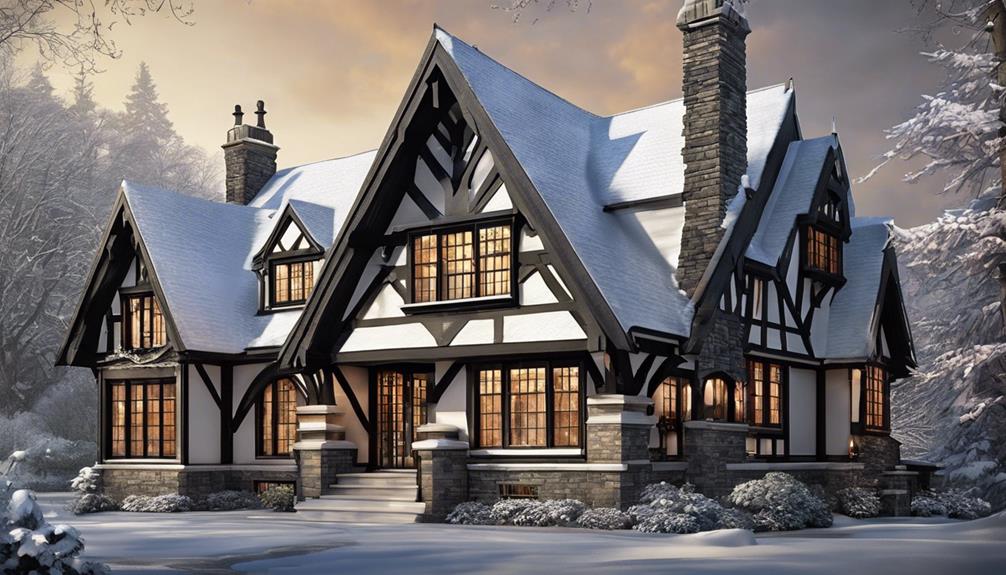
Tudor Revival residences, characterized by their distinctive half-timbering and steep gable roofs, are a prominent architectural style in Canada.
Inspired by medieval English design, these homes often boast asymmetrical layouts and leaded glass windows.
The Tudor Revival movement, emerging in the early 20th century, exudes a blend of historic elegance and modern comfort.
Tudor Revival Features
With their steeply pitched roofs, multiple gables, decorative half-timbering, and tall, narrow windows, Tudor Revival residences exude a charming and intricate old-world charm reminiscent of a bygone era. These homes often feature asymmetrical facades, adding to their unique appeal. Additionally, elaborate chimney stacks and arched doorways with heavy wooden doors are common characteristics. The exteriors of Tudor Revival houses are typically made of stucco or brick, with stone accents enhancing their overall aesthetic. Overall, Tudor Revival architecture captures a romanticized vision of the past, with its detailed craftsmanship and storybook-like quality.
- Asymmetrical facades
- Elaborate chimney stacks
- Arched doorways with heavy wooden doors
- Stucco or brick exteriors with stone accents
- Old-world appearance
Tudor Revival History
Emerging in Canada during the early 20th century, the Tudor Revival architecture movement drew inspiration from medieval English design, ushering in a distinctive blend of elegance, nostalgia, and craftsmanship in affluent neighborhoods. This architectural style is characterized by steeply pitched gable roofs, decorative half-timbering, and tall, narrow windows with small panes, creating a charming and historic aesthetic.
Tudor Revival residences often boast asymmetrical facades, elaborate chimneys, and stucco or stone cladding, evoking a sense of old-world charm and sophistication. Popular in affluent areas, these homes showcase a romantic and picturesque appearance that captivates onlookers with its unique blend of historical elements and modern functionality.
The Tudor Revival style continues to be a timeless and beloved choice for homeowners seeking a touch of classic elegance.
Frequently Asked Questions
What Is the Most Common House Style in Canada?
Detached houses are the most common house style in Canada. They offer space, privacy, and control over structural and aesthetic decisions.
Canadians are most familiar with traditional house types like detached, semi-detached, condos, townhouses, duplexes, split-levels, and bungalows. Tiny homes are gaining popularity due to cost of living increases and changing homeowner priorities.
Each home type offers different benefits and considerations based on location and lifestyle preferences.
What Is the Most Popular Housing in Canada?
Detached houses are the most popular housing type in Canada, providing space, privacy, and autonomy over design choices. Each housing style offers distinct advantages for potential buyers. Location, lifestyle preferences, and market trends influence the popularity of different housing types.
Tiny homes are also gaining traction due to rising living costs and evolving homeowner priorities. Understanding these trends helps us make informed decisions when considering our next home purchase.
What Is a Typical Canadian House?
A typical Canadian house is a detached home with its own space and privacy, often with front and back yards for outdoor enjoyment. Families find these homes ideal for their needs, offering a sense of independence and tranquility.
In contrast to shared walls in other housing styles, detached homes provide a sense of ownership and personalization that many Canadians value. These houses are a popular choice for those seeking a traditional and spacious living environment.
What Type of Architecture Is Canada Known For?
Canada is known for its diverse architectural styles, a reflection of our rich history and cultural influences.
From the elegant Colonial homes to the intricate Victorian designs, our architecture tells a story of our past.
The blend of traditional elements and modern innovations creates a unique blend that caters to various tastes.
Canada's architectural landscape showcases a harmonious fusion of European, Indigenous, and contemporary design influences, making it a truly captivating sight.
Conclusion
In conclusion, Canada boasts a diverse array of popular house styles, ranging from the traditional charm of Victorian and Tudor homes to the modern elegance of West Coast architecture.
Each style offers a unique blend of historical significance, architectural features, and contemporary design elements that cater to the diverse tastes and preferences of homeowners.
Whether you prefer the rustic appeal of Craftsman homes or the sleek lines of modern designs, Canada has a house style for everyone.
- About the Author
- Latest Posts
Introducing Ron, the home decor aficionado at ByRetreat, whose passion for creating beautiful and inviting spaces is at the heart of his work. With his deep knowledge of home decor and his innate sense of style, Ron brings a wealth of expertise and a keen eye for detail to the ByRetreat team.
Ron’s love for home decor goes beyond aesthetics; he understands that our surroundings play a significant role in our overall well-being and productivity. With this in mind, Ron is dedicated to transforming remote workspaces into havens of comfort, functionality, and beauty.
Architecture Home Styles
How to Explore Native Houses in Indonesia
Catch a glimpse of Indonesia's cultural treasures through native houses, where each intricate detail holds a secret waiting to be discovered.

So, you think you've seen it all in Indonesia? Well, think again. Exploring native houses in this diverse archipelago offers a glimpse into a world where tradition meets craftsmanship in a harmonious blend.
From the intricate carvings to the unique architectural designs, each house tells a story waiting to be uncovered, inviting us to step into a realm where time seems to stand still.
But what lies beyond the façade of these cultural gems is a journey that promises to unravel the tapestry of Indonesia's rich heritage, revealing a side often overlooked by many travelers.
Key Takeaways
- Visit Batak, Toraja, and Joglo Houses for diverse architectural experiences.
- Discover intricate carvings and symbolic details in traditional Indonesian homes.
- Immerse in cultural heritage through communal spaces and ancient craftsmanship.
- Learn about Indonesia's rich history and values by exploring native houses.
Traditional Houses in Indonesia
In Indonesia, traditional houses embody rich cultural heritage through their unique architectural designs and symbolism. Among these remarkable dwellings, the boat-shaped houses stand out for their distinctive characteristics. The Batak House, found in certain regions, showcases intricate carvings and utilizes natural materials, reflecting a deep connection to the environment. These boat-shaped structures not only serve as homes but also as symbols of cultural identity and traditions passed down through generations.
The boat-shaped design of these traditional houses in Indonesia not only provides shelter but also represents a deeper meaning within the community. The intricate carvings on the Batak House, for example, tell stories of ancestry and spiritual beliefs, adding layers of significance to the architectural aesthetics. Through these boat-shaped dwellings, the indigenous peoples of Indonesia honor their heritage and preserve their cultural roots in a rapidly changing world.
Cultural Significance of Indigenous Dwellings

Exploring the intricate cultural significances embedded within indigenous dwellings in Indonesia unveils a tapestry of architectural symbolism and traditional values that resonate deeply within the communities they inhabit. These houses serve as more than mere shelters; they embody the cultural beliefs and practices of the diverse Indonesian tribes. The multi-generational living arrangements seen in houses like the Rumah Gadang in West Sumatra and the Rong Houses in Dayak communities highlight the importance of family and community ties in Indonesian society.
Moreover, the communal living spaces found in the Tongkonan House in Tana Toraja and the Uma Lulik in Timor foster a sense of togetherness and shared responsibilities among the inhabitants. Each architectural element, from the intricate carvings to the circular shapes and elevated stilts, holds deep symbolic meaning rooted in centuries-old traditions. These indigenous dwellings aren't just physical structures but living embodiments of Indonesia's rich cultural heritage, where every beam and wall tells a story of cultural continuity and communal harmony.
Top Native Houses to Visit
With intricate architectural designs and rich cultural symbolism, a journey to explore the top native houses in Indonesia promises a captivating immersion into the country's diverse heritage. Here are some of the top native houses you shouldn't miss:
| Native House | Features |
|---|---|
| Batak Houses | Boat-shaped roofs, intricate carvings, spaces for daily life activities like a living room and dining room. |
| Toraja Houses | Distinct saddleback roof design, used in ceremonies, areas for daily life such as a living room and dining room. |
| Joglo Houses | Elaborate wooden structures, symbolizing social hierarchy, with designated spaces for a living room and dining room. |
These native houses offer insights into the daily lives of the people inhabiting them. From the communal spaces like the living room where gatherings take place to the dining room where meals are shared, each house reflects the cultural practices and traditions of its respective community. Exploring these spaces provides a unique opportunity to understand the interconnectedness between architecture, daily life, and cultural identity in Indonesia.
Exploring Architectural Features

Amidst the vibrant tapestry of Indonesia's architectural landscape, one encounters a rich mosaic of cultural intricacies within the native houses that stand as living testaments to the country's diverse heritage. As we delve into exploring the architectural features of these remarkable dwellings, we're greeted by a fusion of craftsmanship and symbolism that captivates the senses:
- Boat-shaped roofs that gracefully mimic the curves of traditional Indonesian vessels, offering a nod to the nation's maritime history.
- Intricate carvings adorning the facades and interiors, telling stories of myths, legends, and ancestral wisdom.
- Wooden craftsmanship that showcases the mastery of artisans, each piece meticulously crafted to perfection.
- Natural materials seamlessly integrated into the structures, connecting the homes to the earth and reflecting a harmonious relationship with nature.
- Symbolic details embedded in every corner, from the layout to the decorations, embodying cultural beliefs and societal values passed down through generations.
Exploring these architectural marvels unveils a world where history, artistry, and tradition converge in a celebration of Indonesia's rich cultural heritage.
Immersing in Indonesian Hospitality
Immerse yourself in the captivating tapestry of traditional Indonesian hospitality by residing in native houses like the Batak House in North Sumatra or the Rumah Gadang in West Sumatra. These native houses not only offer a place to stay but also provide a gateway to the cultural heritage of Indonesia. The intricate carvings, boat-shaped roofs, and eco-friendly construction of these houses showcase the deep-rooted traditions and craftsmanship of the local communities.
Here is a table highlighting some of the unique aspects of traditional Indonesian hospitality found in native houses:
| Aspect | Description |
|---|---|
| Architectural Features | Intricate carvings, boat-shaped roofs |
| Social Significance | Symbolism of social hierarchy in houses like the Joglo House in Central Java |
| Eco-Friendly Construction | Use of sustainable materials like bamboo and thatch in houses like the Sasak House in Lombok |
| Spiritual Connections | Preservation of spiritual connections and communal living traditions in houses like the Uma Lulik in Timor or the Honai House in Papua |
| Local Way of Life | Experience the daily lives and customs of the local communities while staying in these native houses |
Staying in these native houses will not only provide you with a unique accommodation experience but also a deep dive into the rich tapestry of Indonesian traditions and hospitality.
Frequently Asked Questions
What Are Traditional Indonesian Houses Called?
Traditional Indonesian houses are called 'Rumah Adat.' These structures are more than just dwellings; they're living representations of Indonesia's rich cultural tapestry. Crafted from natural materials like wood and thatch, they stand as testaments to the country's diverse traditions.
Each region boasts its own unique design, influenced by local customs and beliefs. Exploring these native houses allows us to delve into the heart of Indonesia's vibrant heritage and architectural ingenuity.
What Is Indonesian Housing Like?
Indonesian housing embodies a rich tapestry of cultures and traditions, showcasing unique architecture and sustainable practices. From boat-shaped roofs to intricate carvings, these homes reflect a deep connection to nature and community.
Families often live together in multi-story structures, fostering bonds and kinship. Sustainability and cultural symbolism intertwine in Indonesian homes, creating a harmonious blend of functionality and heritage preservation.
Each dwelling tells a story of tradition, innovation, and unity.
What Is Typical Indonesian Housing?
We'll dive into the essence of typical Indonesian housing, showcasing the diverse array of styles like Batak, Toraja, Joglo, and more. These houses boast unique architectural features, reflecting the rich heritage of Indonesia's indigenous communities.
From intricate carvings to bamboo and thatch construction, each house tells a story of cultural significance and tradition. Multi-generational living arrangements further deepen the bond between people, highlighting the social and spiritual connections within the community.
What Is a House Called in Indonesia?
In Indonesia, a house is often referred to as a 'rumah' in Bahasa Indonesia. These structures aren't merely places of dwelling; they embody the essence of Indonesian culture and heritage.
Each region has its unique names for traditional houses, such as 'rumah adat' or 'rumah suku,' showcasing the diverse architectural styles and craftsmanship.
These homes serve as living monuments, reflecting the country's history, beliefs, and social structure.
Conclusion
In conclusion, exploring native houses in Indonesia is like taking a journey through a living museum of cultural heritage. Each traditional dwelling tells a story of the past and present, showcasing the craftsmanship and traditions of its people.
By immersing ourselves in these architectural wonders, we can truly appreciate the beauty and diversity of Indonesia's indigenous cultures. So, let's hit the road and dive into the rich tapestry of Indonesian history – the world is our oyster!
- About the Author
- Latest Posts
Introducing Ron, the home decor aficionado at ByRetreat, whose passion for creating beautiful and inviting spaces is at the heart of his work. With his deep knowledge of home decor and his innate sense of style, Ron brings a wealth of expertise and a keen eye for detail to the ByRetreat team.
Ron’s love for home decor goes beyond aesthetics; he understands that our surroundings play a significant role in our overall well-being and productivity. With this in mind, Ron is dedicated to transforming remote workspaces into havens of comfort, functionality, and beauty.
Architecture Home Styles
How Do You Mix Modern and Traditional Art Styles?
Balancing the fusion of modern and traditional art styles in a space can be a captivating challenge – want to know the secret?

When it comes to blending modern and traditional art styles, finding the perfect equilibrium can seem like an insurmountable task. However, by carefully curating a space that seamlessly fuses the two, the results can be awe-inspiring.
But how exactly can this be achieved? Stay tuned as we unravel the intricacies of merging these seemingly contrasting artistic realms to create a harmonious and captivating environment that speaks to the essence of both styles.
Key Takeaways
- Blend colors, materials, and shapes for a cohesive look.
- Establish harmony through shared textures and patterns.
- Use common color palettes and subtle details for cohesion.
- Integrate traditional and modern art for a stylish, effortless design.
Dominant Style Selection
Upon evaluating the home shell and architecture, we determine the dominant style by applying the 80/20 rule, allocating 80% for the primary style and 20% for the secondary style. To achieve a harmonious blend of modern and traditional design, we strategically place traditional pieces as the foundation, anchoring the space with their timeless elegance. Modern art with retro undertones can then be incorporated to infuse a touch of innovation and vitality. By integrating contemporary finds alongside vintage furniture, we create an eclectic yet cohesive overall look that seamlessly marries the two design styles.
Selecting the dominant style is crucial, as it sets the tone for the entire space. By opting for a mix of modern and traditional elements, we can strike a balance that's both refreshing and sophisticated. The key lies in seamlessly blending the two styles to create a visually stimulating environment that captivates the eye and sparks curiosity. When done thoughtfully, the fusion of modern and traditional design can result in a space that isn't only aesthetically pleasing but also rich in character and depth.
Harmony Vs. Contrast

After establishing the dominant style selection in a space blending modern and traditional art styles, the next crucial consideration is determining whether to prioritize harmony or contrast in the overall design approach. When mixing modern and traditional elements, the choice between harmony and contrast plays a significant role in the visual impact of the room.
| Harmony | Contrast |
|---|---|
| Evenly distribute elements from both styles | Use colors and materials to blend or contrast styles |
| Create a cohesive look | Achieve a bold and dynamic effect |
| Balance furniture choices for a calming harmony | Opt for striking contrasts to reflect personal style |
To achieve harmony, blend colors and materials seamlessly, integrating modern and traditional pieces throughout the room. Contrast, on the other hand, can be achieved by strategically placing items that diverge in style, color, or era. Whether aiming for a contemporary feel or a touch of vintage charm, the decision between harmony and contrast will define the overall aesthetic of the space.
Starting With Essential Pieces
We start the design process by focusing on selecting essential furniture pieces that will serve as the foundation for blending modern and traditional art styles in the room. It's crucial to establish a strong base with key elements such as traditional seating arrangements or larger units before introducing modern art pieces or contemporary furniture.
Sofas and tables play a vital role in setting the tone for the space, providing a canvas for layering different styles. When deciding on chairs, strategic placement can add personality and elevate the overall design. Narrowing down furniture choices based on the dominating style helps in determining whether to aim for harmony or contrast when mixing modern and traditional elements.
Tying Art Pieces Together

To achieve a cohesive blend of modern and traditional art styles in a space, the key lies in tying art pieces together through shared colors, shapes, textures, or patterns. When merging different art styles, it's essential to create visual harmony by incorporating common elements that bridge the gap between traditional and modern aesthetics.
Here are five strategies to unify art pieces effectively:
- Utilize a similar color palette: Using shared colors across traditional and modern artworks can create a cohesive appearance and tie the pieces together seamlessly.
- Focus on common shapes: Look for recurring shapes or forms in the art pieces to establish a visual connection and blend the styles cohesively.
- Consider shared textures: Incorporating similar textures in both traditional and modern art can enhance the overall visual cohesion of the space.
- Highlight recurring patterns: Identifying and emphasizing common patterns in the artworks can help unify them and create a harmonious look.
- Pay attention to subtle details: Small details in art pieces can play a significant role in blending traditional and modern styles, so focusing on these nuances is key to achieving a cohesive design.
Adding Final Touches
Incorporating strategic elements like velvet throw pillows and thoughtful lighting choices plays a crucial role in enhancing the fusion of modern and traditional art styles within a space. These final touches serve as the bridge that connects the two worlds, creating rooms that appear effortless and stylish. By mixing traditional and modern aesthetics with a neutral color palette, you can achieve a harmonious balance that's visually appealing.
When adding final touches, consider integrating a vintage piece of art alongside contemporary curves to add depth and character to the room. This juxtaposition of styles creates an eclectic atmosphere that's both intriguing and inviting. Combining modern and traditional styles in this manner allows for a seamless transition between the two, resulting in a space that feels cohesive and well-thought-out.
To master the art of mixing traditional and modern art styles, focus on layering textures, incorporating unexpected elements, and paying attention to the finer details. By following these design tips, you can transform your space into a great place to start experimenting with the fusion of vintage and contemporary art, ultimately achieving a look that's both timeless and fresh.
Frequently Asked Questions
Can You Mix Modern and Traditional Styles?
Yes, we can seamlessly blend modern and traditional styles to create a captivating fusion. By intertwining contemporary elements with classic artistry, we achieve a design that's both timeless and cutting-edge.
This harmonious marriage of old and new offers a fresh perspective and cultivates a rich visual tapestry. Embracing the juxtaposition of modern and traditional styles leads to an innovative approach that sparks creativity and intrigue in interior design.
How Do You Blend Traditional and Modern?
When blending traditional and modern art styles, we aim for a seamless integration that harmonizes the contrasting aesthetics. Finding commonalities in colors, shapes, and textures between the two styles is key.
What Is the Combination of Traditional and Modern Design Called?
The combination of traditional and modern design is known as 'Transitional' style. This aesthetic blends classic elements with contemporary features, creating a balanced and harmonious look.
It seamlessly integrates traditional and modern art pieces, offering a timeless and cohesive space. Transitional design emphasizes comfort, warmth, and simplicity with clean lines and a minimalistic approach.
It aims to merge elements from different eras to achieve a cohesive and innovative design.
How Do You Combine Different Art Styles?
When combining different art styles, we focus on harmony and contrast. By blending complementary colors and themes and experimenting with various mediums, we create a cohesive yet dynamic visual experience.
Symmetry and asymmetry play a crucial role in adding balance and interest to our art arrangements. Dominant styles serve as focal points, while contrasting ones add depth and dimension.
Ultimately, our goal is to personalize spaces and evoke a sense of creativity and innovation.
Conclusion
In conclusion, blending modern and traditional art styles is a delicate dance of balance and creativity. By carefully selecting a dominant style, harmonizing or contrasting elements, and layering essential pieces with unique art, textiles, lighting, and plants, a space can truly come to life.
Embracing imperfections and experimenting with unexpected themes adds depth and personality to the mix. The result? A visually captivating and harmonious fusion of the old and the new.
- About the Author
- Latest Posts
Introducing Ron, the home decor aficionado at ByRetreat, whose passion for creating beautiful and inviting spaces is at the heart of his work. With his deep knowledge of home decor and his innate sense of style, Ron brings a wealth of expertise and a keen eye for detail to the ByRetreat team.
Ron’s love for home decor goes beyond aesthetics; he understands that our surroundings play a significant role in our overall well-being and productivity. With this in mind, Ron is dedicated to transforming remote workspaces into havens of comfort, functionality, and beauty.
Architecture Home Styles
How to Have a Tiny Home in Arizona: Your Essential Guide
Fascinated by the idea of a tiny home in Arizona? Discover how tax considerations can impact your journey in this essential guide.
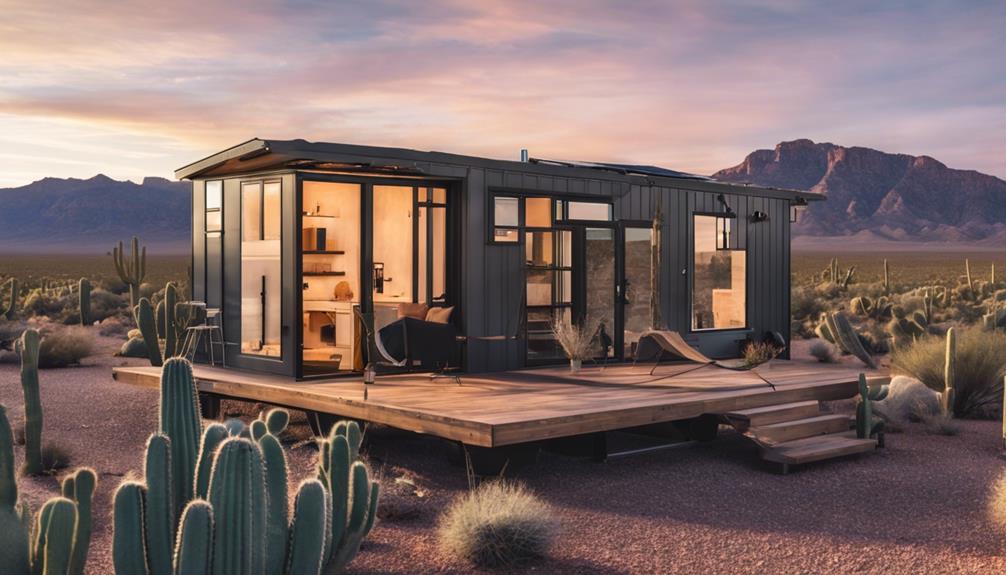
Embarking on the journey of having a tiny home in Arizona is like navigating through a desert oasis, each step revealing new insights and challenges. From understanding the intricate web of zoning laws to discovering the perfect location that aligns with your tiny living dreams, this essential guide equips you with the knowledge needed to turn your tiny home vision into reality.
But what about the unique tax considerations that come with owning a tiny home in Arizona? Stay tuned to uncover key insights that will make a difference in your tiny home journey.
Key Takeaways
- Understand Arizona zoning laws for placement in suitable zones.
- Seek permits for tiny homes based on location and structure type.
- Explore tax benefits for tiny homeowners through property tax exemptions.
- Build a supportive community through local groups and events for guidance.
Zoning Laws and Regulations in Arizona
When navigating the realm of tiny home living in Arizona, understanding the intricacies of zoning laws and regulations becomes paramount. In Arizona, zoning laws permit tiny houses on foundations in multifamily, detached single-family, and accessory dwelling unit zones.
However, for Tiny Homes on Wheels, they're typically classified as recreational vehicles and must adhere to specific parking regulations within designated zones. Maricopa County has established particular regulations for tiny houses, including constraints on the floor area allowed for permanent structures. On the other hand, Pima County imposes restrictions on Tiny Homes on Wheels through specific codes that govern their placement.
The zoning options for tiny houses in Arizona encompass various zones such as isolated single-family zones, accessory dwelling unit zones, and multifamily zones. Familiarizing oneself with these zoning laws and regulations is crucial for anyone considering embarking on the adventure of tiny home living in Arizona.
Ideal Locations for Tiny Homes
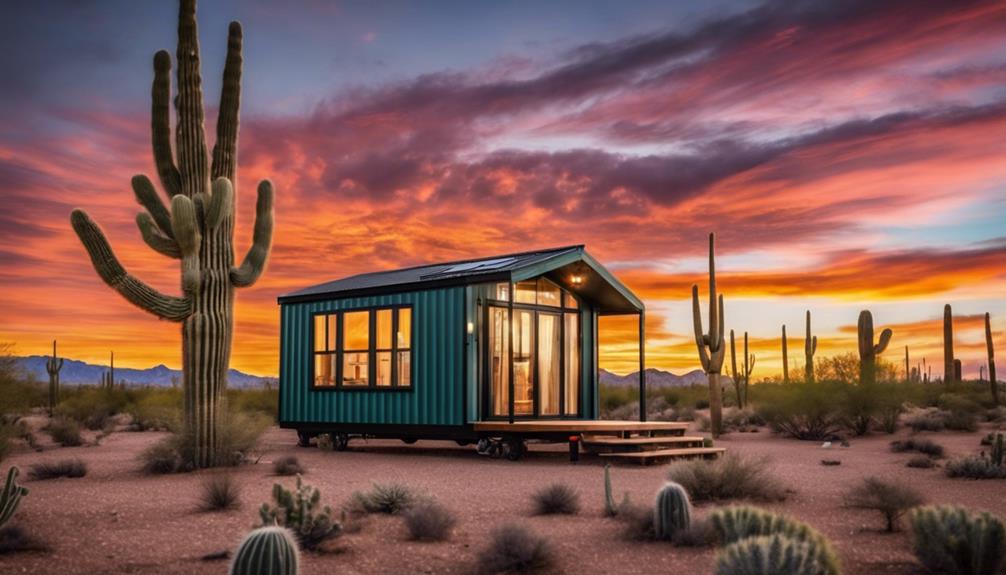
For those seeking ideal locations to establish their tiny homes in Arizona, cities like Phoenix, Tucson, Sedona, and Lakeside present attractive options. When considering where to set up your tiny home in Arizona, keep in mind that Pima County and Coconino County permit the establishment of tiny houses in specific zones. In these areas, tiny homes can be placed in isolated single-family zones, ADU zones, and multifamily zones. For those with tiny houses on wheels, it's important to note that they must be parked in designated R.V. zones in compliance with regulations.
- Phoenix, Tucson, Sedona, and Lakeside are ideal cities for setting up tiny homes in Arizona.
- Pima County and Coconino County allow tiny houses in specific zones.
- Tiny homes can be placed in single-family zones, ADU zones, and multifamily zones.
- Tiny houses on wheels must adhere to regulations in designated R.V. zones.
Tax Considerations for Tiny Home Owners
Exploring the tax implications of owning a tiny home in Arizona reveals potential benefits and considerations that can significantly impact financial planning for homeowners. Tiny home owners in Arizona may qualify for property tax exemptions based on factors like square footage and adherence to green building standards. Additionally, the size of tiny homes could lead to reduced property tax assessments in certain counties. It is crucial for Arizona tiny home owners to familiarize themselves with local tax laws to take advantage of any available tax benefits. Seeking guidance from a tax professional or local tax assessor can provide valuable insights into how owning a tiny home in Arizona may influence property taxes.
Tax Considerations for Tiny Home Owners:
| Key Points | Details | Importance |
|---|---|---|
| Property Tax Exemptions | Available based on square footage and green standards | Maximize Savings |
| Reduced Assessments | Smaller homes could mean lower tax bills | Financial Advantage |
| County Variances | Regulations differ, impacting tax benefits | Local Compliance |
| Professional Advice | Consult with tax professionals for guidance | Optimal Planning |
Finding Community Support in Arizona

By actively engaging with local resources and networking opportunities, tiny home enthusiasts in Arizona can establish a strong sense of community support to enhance their living experience.
Here are some ways to find community support in Arizona:
- Join local Facebook groups like 'Arizona Tiny House Community' for a supportive network.
- Attend tiny house meetups and events in Arizona to connect with like-minded individuals.
- Explore tiny house workshops and seminars in the state to gain knowledge and resources.
- Consider volunteering with non-profit organizations focused on sustainable living and tiny house advocacy in Arizona.
These opportunities not only provide a sense of belonging within the tiny house community but also offer valuable insights, resources, and support for those embracing the tiny home lifestyle in Arizona.
Engaging with these avenues can enrich your experience, foster connections, and empower you to navigate the challenges and joys of sustainable living in the state.
Building and Parking Tips for Tiny Homes
Engaging with the regulations and guidelines for building and parking tiny homes in Arizona is crucial for ensuring compliance and a smooth transition into sustainable living. Tiny homes on foundations in Arizona must adhere to the 2018 IRC Appendix Q requirements, which outline specific space dimensions and safety features to guarantee structural integrity.
Building a tiny home on skids offers a semi-permanent placement option while still allowing for mobility if relocation becomes necessary. For those opting for tiny homes on wheels, meeting mobile home requirements is essential, and a minimum of 160 square feet is required for parking.
The flexibility in setting up tiny homes in various zone types in Arizona provides diverse housing options based on individual preferences. Tiny houses on wheels are particularly popular for their mobility and flexibility, making them an attractive choice for those desiring a minimalist lifestyle without sacrificing comfort.
Frequently Asked Questions
Can I Put a Tiny House on My Property in Arizona?
Yes, we can put a tiny house on our property in Arizona if it complies with local zoning regulations. Different options like multifamily, detached single-family, or accessory dwelling units are available. Land near Maricopa City, Pinal County, offers accessible placement.
How Much Does a Tiny House Cost in Az?
Tiny houses in Arizona can range from $20,000 to $200,000 depending on size and customization. DIY kits start at $8,000, but labor costs add up. Land, utilities, and permits are extra. Building a tiny house can be a cost-effective housing choice.
What Is the Minimum Square Footage for a House in Arizona?
In Arizona, the minimum square footage for a house varies based on its foundation type. For tiny houses on foundations, it's 200 square feet, while those on trailers require at least 160 square feet. Adhering to building codes is essential.
Does Arizona Have a Tiny Home Community?
We do have tiny home communities in Arizona. These communities provide shared amenities, community engagement, and a supportive environment. Living in a tiny house community offers a unique sense of belonging, shared resources, and a close-knit experience.
Conclusion
In conclusion, navigating the world of tiny homes in Arizona may seem like a daunting task, but with the right resources and community support, it can be a breeze.
From zoning laws to building tips, we've covered it all in our essential guide.
So go ahead, take the leap into tiny home living and watch your dreams of a cozy, sustainable lifestyle come to life in the Grand Canyon State!
- About the Author
- Latest Posts
Introducing Ron, the home decor aficionado at ByRetreat, whose passion for creating beautiful and inviting spaces is at the heart of his work. With his deep knowledge of home decor and his innate sense of style, Ron brings a wealth of expertise and a keen eye for detail to the ByRetreat team.
Ron’s love for home decor goes beyond aesthetics; he understands that our surroundings play a significant role in our overall well-being and productivity. With this in mind, Ron is dedicated to transforming remote workspaces into havens of comfort, functionality, and beauty.
-

 Retreat6 days ago
Retreat6 days agoDIY Aromatherapy Diffusers for a Spa-Like Atmosphere at Home
-

 Retreat2 weeks ago
Retreat2 weeks agoThe Profitability of Retreat Centers: A Financial Analysis
-

 Retreat1 week ago
Retreat1 week agoUnusual DIY Projects: Designing a Space Probe in Bitlife
-

 Retreat2 weeks ago
Retreat2 weeks agoComprehensive Review: Are Home Decorators Ceiling Fans Worth the Investment?
-

 Retreat1 week ago
Retreat1 week agoIs Opening a Home Decor Store Profitable in 2024?
-

 Retreat1 week ago
Retreat1 week agoHow to Create a Zen Garden for Your Retreat Center
-

 Retreat2 weeks ago
Retreat2 weeks agoStep-By-Step Tutorial: Reupholstering a Chair With Buttons
-

 Retreat4 days ago
Retreat4 days agoThe Psychology of Color in Retreat Center Design











